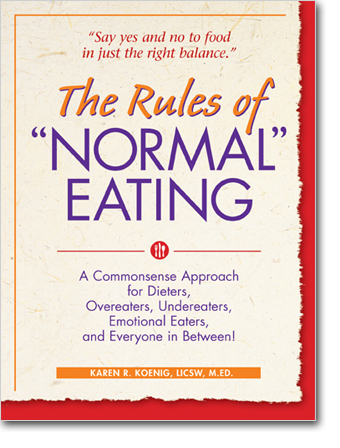
The Rules of "Normal" Eating
A Common Sense Approach for Dieters, Overeaters, Undereaters, Emotional Eaters, and Everyone in Between!
by Karen R. Koenig, LICSW, M.Ed.
DUMP DIETING IN FAVOR OF FOLLOWING THE RULES
Rejection, loneliness, jealously, boredom—we’ve all experienced these difficult emotions at one time. But for many people, troublesome feelings translate into emotional overeating or food deprivation. If you’ve ever binged on carton of ice cream after a bad day or denied yourself food as a punishment for not feeling good enough, you’re not alone.
Karen R. Koenig, a psychotherapist and educator, used to overeat and diet herself. “I hated bingeing,” she explains. “Everyday was a low point. I wanted desperately to be thin, to be valued and loved. I wanted to be in control around food because I was terrified of it. I had no idea it could be any other way.” Many disordered eaters live in this world of secret shame, unable to get a handle on their obsessive thoughts. Many don’t realize that ending the dieting roller coaster and learning to trust their body’s signals are realistic, obtainable goals.
Now the author of a new book, The Rules of “Normal” Eating, Koenig considers herself basically a “normal” eater, which means that she separates feeling from eating. “It was a completely new way to relate to food—by actually listening to and trusting my body,” says Koenig. “I still occasionally have knee-jerk reactions to food or eating. I’m like a person who has been injured and walks with a barely perceptible limp. I accept that I might never eat like someone who has never had this problem. I don’t expect to be perfect.”
“Normal” eaters follow four basic rules—they 1) eat when they’re hungry or have a craving, 2) choose satisfying foods, 3) eat with awareness and enjoyment by staying connected to their bodies, and 4) stop eating when they’re full or satisfied. These rules may sound obvious, but for disordered eaters who may have struggled with the pattern of stuffing or staving themselves for years, they’re like a foreign language.
Someone who eats restrictively may be using obsessive calorie counting or dieting as a way to tune out problems or cope with stress. Or, someone who mindlessly eats or eats to numb feelings of emptiness in their life may also be using food as an emotional bandage. Many people forget that food is the solution to one thing only—hunger. While everyone occasionally overeats or skips means, “normal” eaters do not rely on food—avoiding it, obsessing about it, or gorging on it—to deal with problems.
Becoming a “normal” eater won’t happen overnight though, especially if you’re an expert at using food to avoid pain. It’s easy to forget the real reason we experience discomfort in the first place—because something is wrong in our life. Says Koenig, “If a bicycle ran over your foot, you’d probably be in pain and would get rapid medical attention. But if a lover runs over your heart, what do you do? You feel the pinch of pain and head for the linguini or decide you’ll skip lunch because maybe he’ll come back if you’re thinner. You might as well run an IV of novocaine straight to your heart and be done with feeling forever.”
Underneath those layers of feelings are the real culprits, negative beliefs that have been accepted and reiterated. It can be scary to look inside our mental file cabinet of good-for-nothing beliefs, but this is where most of the food, eating, and body image problems hide. Doing a 180-degree turn to uproot these negative beliefs create real change. As Koenig explains, “Transforming your relationship with food will take nothing less than total awareness of your beliefs, feelings, and behaviors, along with tons of courage. This kind of change is like giving birth to a new self, a brand new you.”
Creating healthy beliefs will likely improve many areas of your life: a healthier self-image, satisfying relationships, and a positive, “normal” relationship with food.